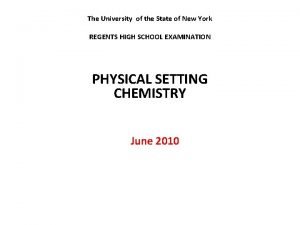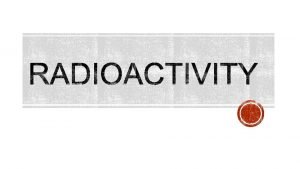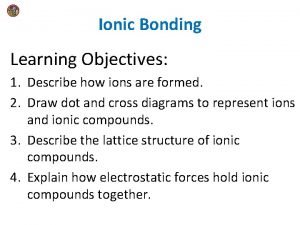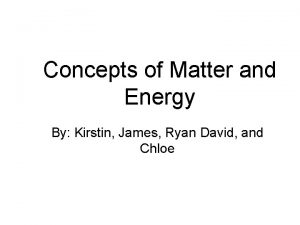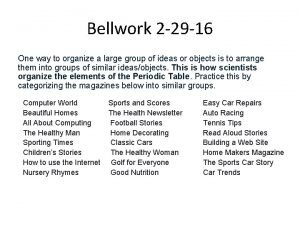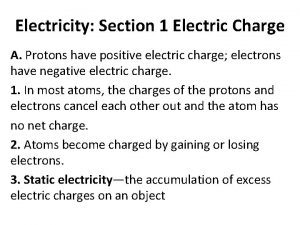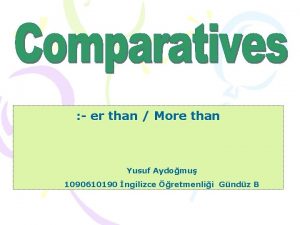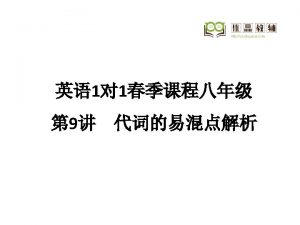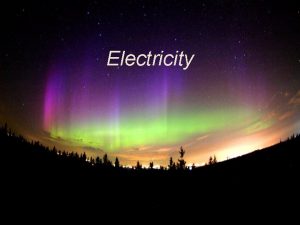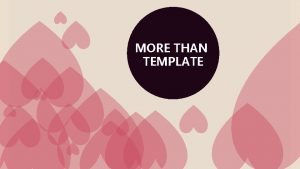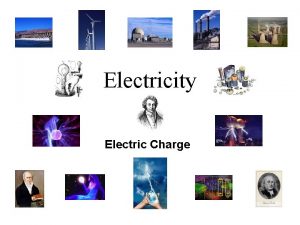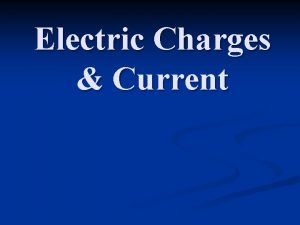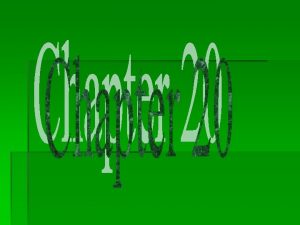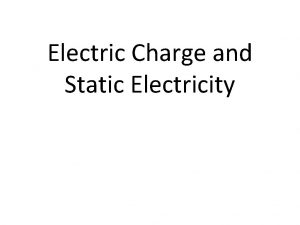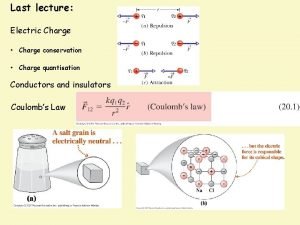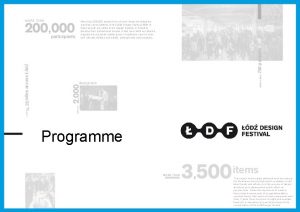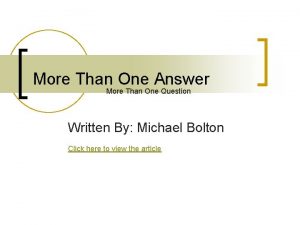Electric Charge Electric Charge Rules More protons than















- Slides: 15

Electric Charge • Electric Charge Rules: – More protons than electrons: ________ – More electrons than protons: ________ • So if an atom gains an electron, it becomes a ___________ – Like charges _____; opposite charges ______ • Causes the flow – In electricity, ONLY e- move, not protons! • Strength of electric force due to – ________ of charge involved – How _________the charges are

Electric Field • ______: region around charged particles in which others will attract or repel – Note: Strength of the field depends on • __________ produced • _______ from charge

Static Electricity and Charging • Charge can be transferred by ______, ______ & ________ • Friction – Ex • rubbing a balloon against your hair • ____________ • Contact – Ex - Touching a __________ generator • Induction - when charge is transferred ________ contact – A neutral metal comb becomes charged by being held near a charged object

Flow of Electricity • ____________: flow of ethrough a wire – Symbol for current is ___ – Current is measured in ______, or ______ for short • �current = �e-

• _______: opposition to flow of electricity – Symbol for resistance is R – Resistance is measure in _____, which is represented by _____ – _____ conductors have ______ resistance (or low conductivity) • Ex. Iron – _____ conductors have _______ resistance (or high conductivity) • Ex. Copper – Long and thin wires have more resistance than short and thick wires • Resistance is affected by a material’s thickness, length and temperature – Any device that you plug in is called a ______ (load)

Flow of Electricity • Conductors & Insulators – ________ – material charge can flow through easily • Ex – metal such as copper & silver – ________ – material charge can not flow through easily • Due to electrons being tightly bound to its atoms • Ex. – wood, plastic, rubber, air, glass

Flow of Electricity cont. , • _____: – current in a wire =voltage/resistance (____) • Current Directions: – Direct Current (____): electrons flow in the same direction • Ex. Batteries (e- flow through and terminal) – Alternating Current (____): Electrons constantly change their direction of flow • Ex. Electricity from power plants (via generators); therefore the electricity in your home and school is mostly alternating current. • The electricity from power lines needs to go through a _________ before it can be used by your home • Power __ = _______ X ____ (______ = ______ X _____)

Electric Currents • What’s a Circuit? – Provides a _____, _______ for an electric current to flow – Circuit works when path is _____; doesn’t work when path is ______ • Parts of a Circuit: – A ______ of e- (i. e. battery, outlet) – A ____ (resistance) which is the device that uses the electricity – ______ carry the electrons – A _____, which opens or closes the circuit

Series Circuit • Only ______ path for a current to flow • All parts of the circuit are connected one after the other – Ex. Old Christmas Lights • Same ______ (I) passes through each resistor • Current stays the same • Voltage _____ after each resistor

Parallel Circuit • Different parts of circuit are on _______ branches • Several ____ for electrons can be taken – Ex. New Christmas Lights – Ex. Circuits in your home • Voltage ______ • Current ______ through each branch

Electrical Safety • ________ – Wire in the center of the fuse melts when ______ passes through it • ______________ – A switch opens when the ____ is too high • Ground-fault circuit interrupter (_____) – Monitors current flowing to and from an outlet or appliance – If current is _______ →current is escaping and the GFCI opens the circuit to prevent serious electric shock

Magnetism • All magnets have _______ & _______ – If you break a bar magnet in half, each half will become a bar magnet with two poles • Rule for magnetic poles: like poles ____/opposites ______ • Magnetic Field = region in which magnetic forces can act – Earth has one around it (_________); strongest at poles – Magnetic lines of force define these areas – Electrons in atoms spin, causing the magnetic field • Magnetic Force – as two magnets move farther apart, the ______

Electromagnetism • Electricity and magnetism are inseparable • __________: made by winding wire around an iron core – Will have N and S poles – Polarity of magnet depends on polarity of electric current • Magnetism can induce ________ • Electricity can induce ________

Electromagnets • Electric Wire wrapped around an iron core • These are _______; can be turned on and off – Ex. Doorbells, telephones, electric motors • Moving a magnet inside a coil of wire will induce a voltage in the coil – The _______ the magnet moves →the _____ the voltage

Electric Generator • Changes _______ energy into _______ energy • Loop of wire (conductor) spins inside a magnetic field to create electricity; known as an electromagnetic induction • Most of the power you use everyday comes from __________ – Burning of fossil fuels creates _______ that spins a _____ which turn the coils in a – In Michigan, the major of fossil fuel is will generator source _____
 Lirik lagu more more more we praise you
Lirik lagu more more more we praise you More more more i want more more more more we praise you
More more more i want more more more more we praise you Can an atom have more neutrons than protons
Can an atom have more neutrons than protons Can an atom have more neutrons than protons
Can an atom have more neutrons than protons Positive ions are atoms that have
Positive ions are atoms that have Can an atom have more neutrons than protons
Can an atom have more neutrons than protons Does mercury have more protons and electrons than tin
Does mercury have more protons and electrons than tin Example of charge by contact
Example of charge by contact More er than
More er than 5730x5
5730x5 Greater than god and more evil
Greater than god and more evil Difference between charge and electric charge
Difference between charge and electric charge Difference between static and current electricity
Difference between static and current electricity Chapter 21 electric charge and electric field
Chapter 21 electric charge and electric field Chapter 21 electric charge and electric field
Chapter 21 electric charge and electric field Chapter 16 electric charge and electric field
Chapter 16 electric charge and electric field


